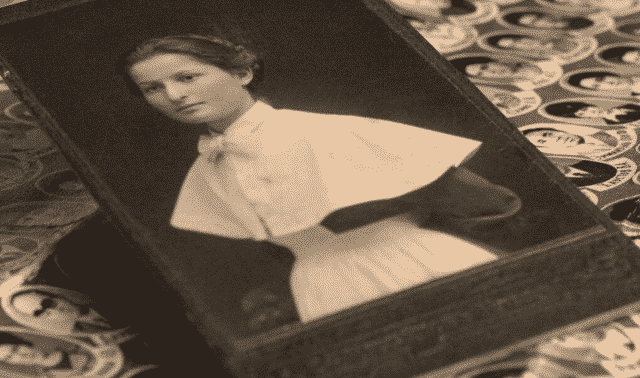Years ago when my children were little, I took them to a portrait studio to have their pictures taken. In addition to the standard 8 x 10-inch and 5 x 7-inch prints, the studio asked if I wanted a miniature portrait in a piece of jewelry. I selected a charm I could dangle from a bracelet.
Photographic jewelry isn’t a contemporary invention. Beginning with the daguerreotype in 1839, photographers had the tools and equipment to set images in rings, bracelets, stick pins and even buttons. All types of pictures—daguerreotypes, ambrotypes, tintypes and paper prints—appear in jewelry. I briefly discussed such accessories in an earlier column.
Sheryl Finn submitted this portrait of a woman she thinks is her great-grandmother Grace, who was born in 1869, wearing a piece of photo jewelry. Finn wants to know when and where this portrait was taken, and if the pin contains a family photo or a decoration.
Antique Photographic Jewelry: Tokens of Affection and Regard (West Companies, $125) by Larry J. West and Patricia A. Abbot is the first book dedicated to the topic of photo jewelry. The authors discuss types (decorative, functional and commemorative), differences between European and American examples, jewelry makers, how 19th-century women wore it, and collecting the pieces. It’s a fantastic tome filled with gorgeous pictures, including some showing pieces similar to the pin in this photo.

Based on the hairstyle and high-collared, stitch-decorated bodice, this portrait dates from around 1900. Finn’s great-grandmother would be 30 years of age in the photo. This woman looks younger, raising the possibility she’s another relative. Finn needs a positive ID for this woman to determine where it was taken, since there’s no photographer’s imprint on the image. <!–
Provenance–>
Take a look at the close-up of the pin: It’s a paper print of young man in a brass or gold setting. Since most women wore jewelry of loved ones to signify affection or to be photographed ?with? them, it probably depicts a husband, beau or brother. According to West and Abbott, pins were the second most popular form of photo jewelry—right after the combination watch-locket.
If you own a piece of photo jewelry, treat it kindly. This type of accessory was common in the 19th century, but many pieces later disappeared when individuals melted down or reused the settings and threw away the picture. Look carefully at your family photographs for glimpses of these treasured accessories, and to add another portrait to your collection. Photo-jewelry is fun, beautiful and often valuable. It definitely qualifies as a family heirloom, but it’s wearable as long as the setting is in good shape. If you have a newer image in an older setting, such as a locket, gently look behind the image to see if another picture is behind it. You might be surprised to uncover one or more pictures. <!–
Helping Hands
Although family recollections are usually the best way to identify a photograph, relatives don’t always know who’s pictured. –>




